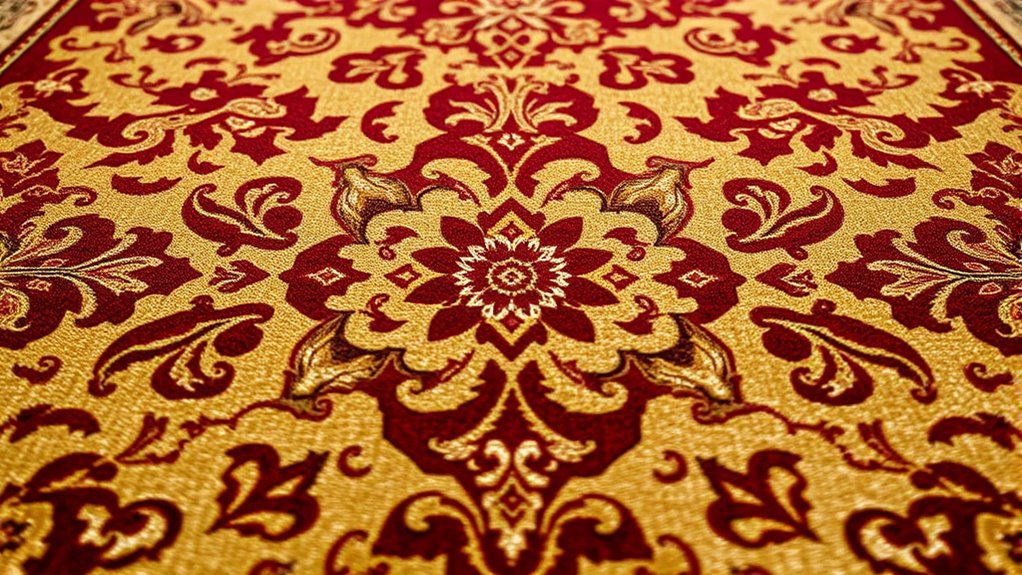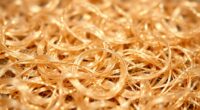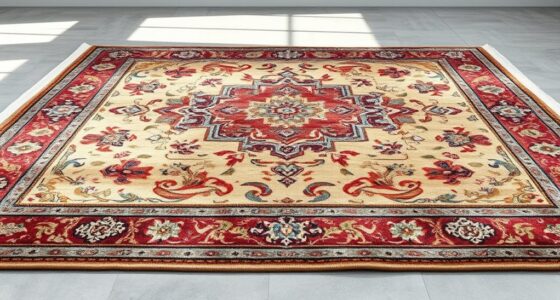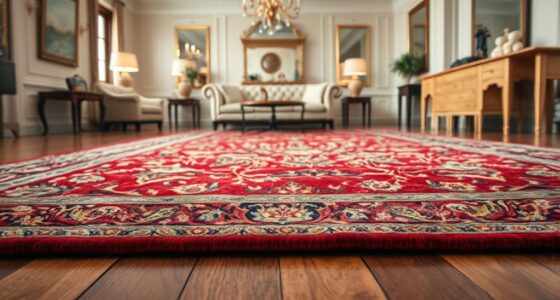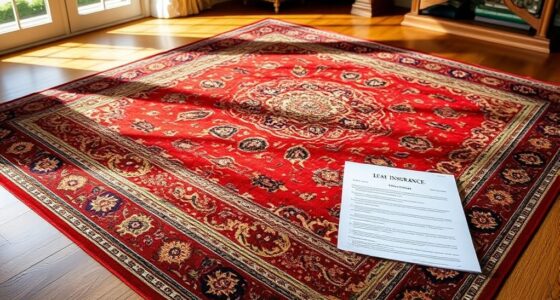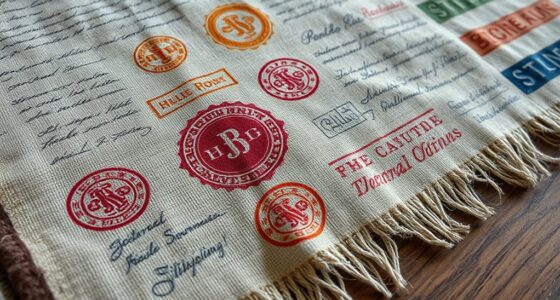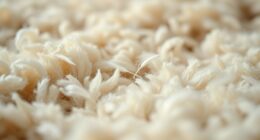Royal provenance rugs showcase expert craftsmanship, rich symbolism, and diplomatic importance. Famous pieces like the Ardabil Carpet and Ottoman palace rugs demonstrate intricate designs and cultural stories, while gifts like the Sultan’s tapestry highlight their role in fostering alliances. Preserving these masterpieces requires careful techniques, ensuring we comprehend their history and artistry. By exploring these textiles further, you’ll discover valuable lessons on tradition, diplomacy, and the lasting legacy of exquisite craftsmanship.
Key Takeaways
- Famous royal rugs include the Ardabil Carpet, Mughal Rugs, and Ottoman Palace Rugs, each representing unique cultural and artistic traditions.
- These rugs demonstrate craftsmanship, intricate designs, and symbolism reflecting political, spiritual, and cultural values.
- They serve diplomatic roles, strengthening alliances and showcasing craftsmanship in international relations.
- Preservation and provenance verification are vital to maintain authenticity, historical integrity, and cultural legacy.
- Studying royal rugs teaches lessons on durability, traditional techniques, artistry, and the importance of careful conservation.
The Pahlavi Carpet: A Symbol of Modern Iranian Heritage
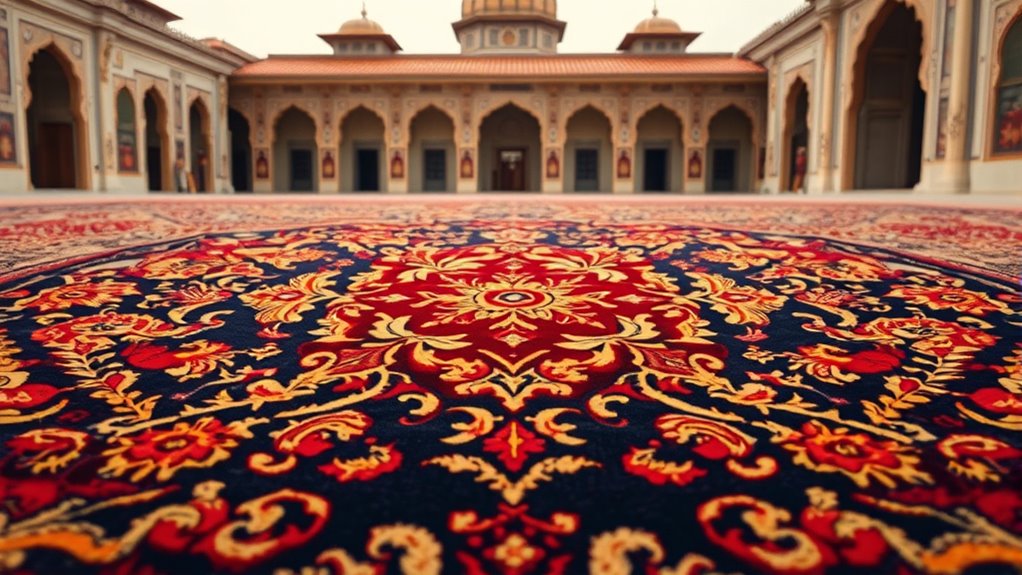
The Pahlavi carpet stands as a striking symbol of Iran’s modern heritage, blending traditional craftsmanship with national pride. Its intricate design reflects a deep cultural symbolism that resonates with Iran’s history and identity. As you explore its textile conservation, you’ll notice how specialists carefully preserve its vibrant colors and delicate fibers, ensuring its legacy endures. This effort highlights the importance of safeguarding cultural artifacts that embody Iran’s evolving artistic expressions. The carpet not only showcases masterful weaving techniques but also serves as a visual narrative of Iran’s modern identity, bridging past and present. Additionally, textile conservation techniques are crucial for maintaining the carpet’s durability and appearance over time. These methods often involve specialized preservation strategies that protect against environmental damage, ensuring its longevity. Furthermore, understanding the cultural symbolism embedded in the design enhances appreciation of its historical significance. By maintaining its condition, you help preserve an essential piece of Iran’s cultural symbolism, allowing future generations to appreciate its significance. Recognizing the artistic craftsmanship involved deepens the connection to Iran’s rich artistic heritage.
The Ardabil Carpet: An Imperial Masterpiece of Persia
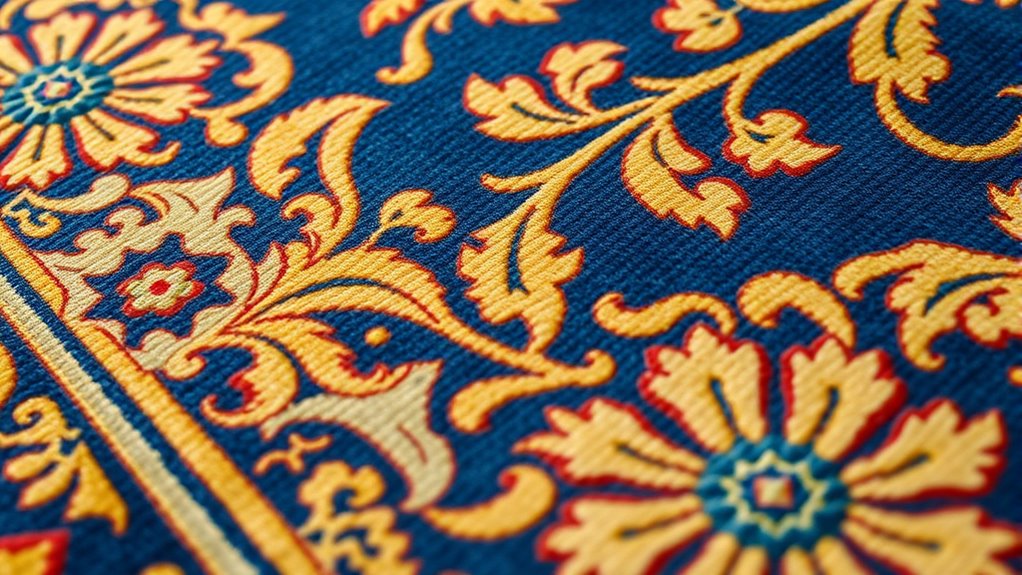
Building on Iran’s rich tradition of textile artistry, the Ardabil Carpet stands out as an unparalleled masterpiece that embodies the grandeur of Persia’s imperial era. Its intricate weaving techniques showcase masterful craftsmanship, with each knot carefully crafted to create detailed patterns and a sense of depth. The dyes used in the carpet hold deep symbolism, with colors like indigo and madder representing spiritual and political significance. You can observe how the weaving techniques contribute to the carpet’s durability and richness, while the dye symbolism reflects cultural values and religious beliefs. Additionally, the top beach towns on the East Coast offer a variety of scenic views and cultural experiences that parallel the artistry found in Persian textiles. The choice of dyes and weaving methods also highlights the importance of traditional craftsmanship techniques, which have been passed down through generations to preserve the cultural heritage. The dyes’ chemical composition influences their longevity and vibrancy, ensuring the carpet’s beauty endures over time. Moreover, understanding the dyeing process provides insight into how traditional methods enhance both the aesthetic and symbolic qualities of the textile. This combination results in a design that isn’t just decorative but also meaningful, revealing the sophistication and artistry of Persian weavers. The Ardabil Carpet remains a testament to Persia’s artistic mastery and cultural heritage, showcasing the enduring legacy of textile craftsmanship.
The David Collection’s Mughal Rugs: Artistic Fusion of Cultures
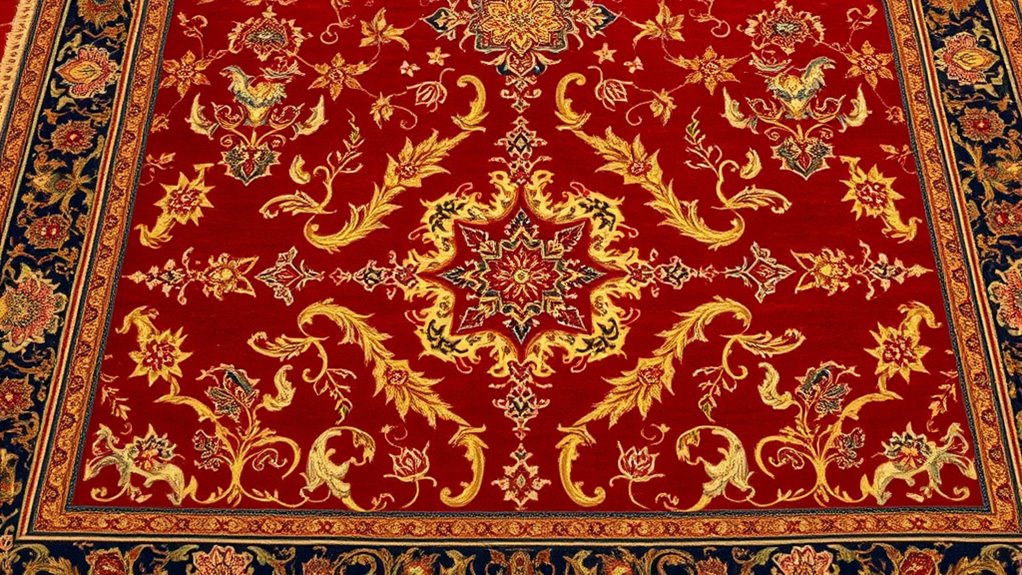
As you explore the Mughal rugs in the David Collection, you’ll notice how they embody a mesmerizing fusion of Persian, Indian, and Central Asian artistic traditions. This reflects a rich cultural exchange that shaped their design and craftsmanship. The rugs showcase unique artistic techniques, blending intricate floral motifs, geometric patterns, and vibrant colors. They reveal a sophisticated dialogue between different cultures, evident in the detailed medallions and border designs. To better understand, consider this table:
| Cultural Influence | Artistic Technique | Notable Feature |
|---|---|---|
| Persian | Symmetrical patterns | Floral medallions |
| Indian | Bright color palette | Geometric borders |
| Central Asian | Fine knotting | Complex motifs |
These elements highlight how these rugs are masterpieces of cross-cultural artistry. Cultural exchange played a vital role in inspiring the diverse motifs and craftsmanship seen in these remarkable pieces. Recognizing the importance of artistic techniques can deepen appreciation for their craftsmanship and cultural significance. Additionally, studying the historical context of these regions can provide further insight into their artistic evolution, emphasizing how cross-cultural influences contributed to their distinctive styles. Furthermore, examining the craftsmanship involved can offer a greater understanding of the skill and tradition behind these extraordinary textiles.
The Sultans’ Tapestry: Ottoman Rugs in Royal Palaces
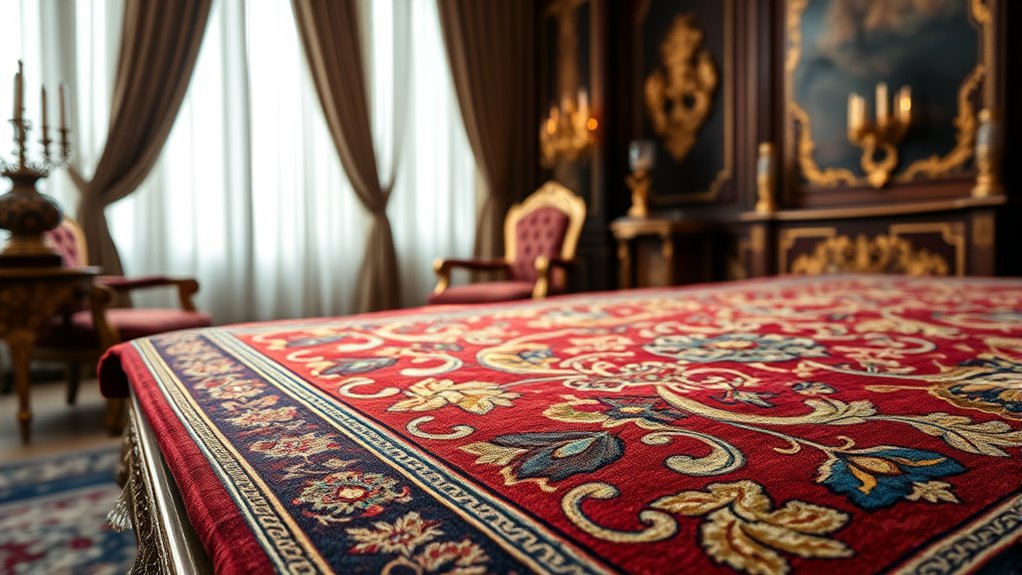
Ottoman rugs played a key role in the decor of royal palaces, showcasing intricate designs and luxurious craftsmanship. You’ll notice that their symbolism and motifs reflect the empire’s cultural and political ideals. Preserving their authenticity helps us understand the true artistry and historical significance behind these timeless pieces. Additionally, understanding the role of cultural symbolism in these textiles enriches our appreciation of their historical context. Many of these motifs also reveal traditional craftsmanship techniques, which have been handed down through generations of artisans. Recognizing the existential themes embedded in their designs can deepen our connection to the cultural narratives they convey.
Ottoman Palace Decor
Within the opulent chambers of the Ottoman palaces, rugs served more than just decorative purposes—they embodied status, artistry, and cultural identity. These intricate pieces often reflected the sultans’ wealth and taste, blending medieval tapestry techniques with fine textile conservation. As you explore these spaces, you’ll notice how the rugs enhance the grandeur and atmosphere of each room. They weren’t merely for show but also served practical and symbolic roles. Consider how:
- They displayed complex motifs representing power and tradition.
- Their preservation involved careful textile conservation methods.
- Rugs were used to insulate and soften the palace floors.
- They connected Ottoman craftsmanship with wider artistic influences.
These pieces tell stories of craftsmanship and history, elevating palace decor to a form of living art.
Symbolism and Motifs
The motifs and symbols woven into Ottoman palace rugs convey powerful messages about authority, spirituality, and cultural identity. Mythical symbolism plays a key role, often depicting legendary creatures or divine figures to emphasize the ruler’s divine right and protection. Floral motifs are equally significant, representing paradise, renewal, and abundance, and often serve as visual expressions of paradise on earth. These intricate designs aren’t just decorative; they encode stories, beliefs, and social status. You’ll notice that motifs like tulips, carnations, and pomegranates carry deeper meanings tied to Ottoman values and religious themes. By understanding these symbols, you gain insight into the cultural fabric of the empire and the way rulers used art to communicate power and spiritual harmony within their palaces.
Preservation and Authenticity
Preserving the intricate beauty and historical integrity of palace rugs requires careful attention and expert conservation. To maintain their authenticity, you must focus on advanced restoration techniques that address wear and damage without compromising original craftsmanship. Provenance verification is essential, ensuring each piece’s history aligns with its royal origins. When caring for Ottoman rugs, consider these key practices:
- Conduct thorough documentation of the rug’s condition and history
- Use non-invasive cleaning methods to prevent deterioration
- Employ skilled conservators trained in traditional techniques
- Regularly monitor for environmental factors like humidity and light exposure
The Koh-i-Noor of Carpets: The Mughal-Influenced Royal Weaving
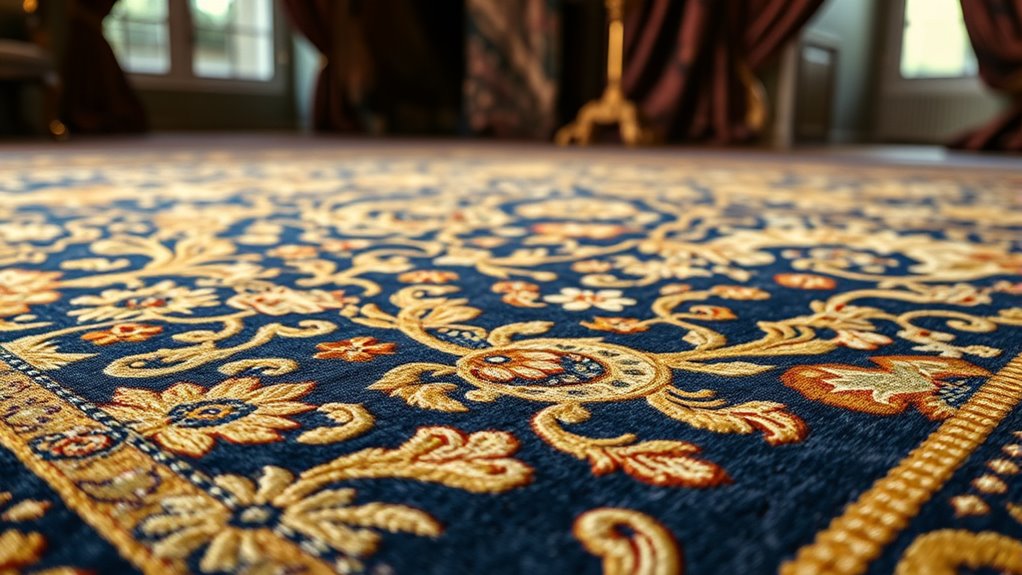
Although often overshadowed by gemstones, the Mughal influence on royal carpets stands out as a proof of craftsmanship and opulence. You’ll notice intricate weaving techniques that create detailed, symmetrical patterns, reflecting masterful skill. Mughal weavers employed advanced dyeing methods, producing vibrant, lasting colors that highlight the richness of the designs. These techniques allowed for complex motifs, often inspired by Persian and Indian art, to be rendered with precision. The use of natural dyes gave the carpets a luminous quality that endures through centuries. Such craftsmanship signified both wealth and cultural sophistication, making these carpets treasured royal possessions. Their detailed work, vibrant hues, and historical significance mark them as true masterpieces, often called the Koh-i-Noor of Carpets for their unmatched prestige and beauty.
The Shah Abbas Carpet: Persian Royal Patronage in the Safavid Era
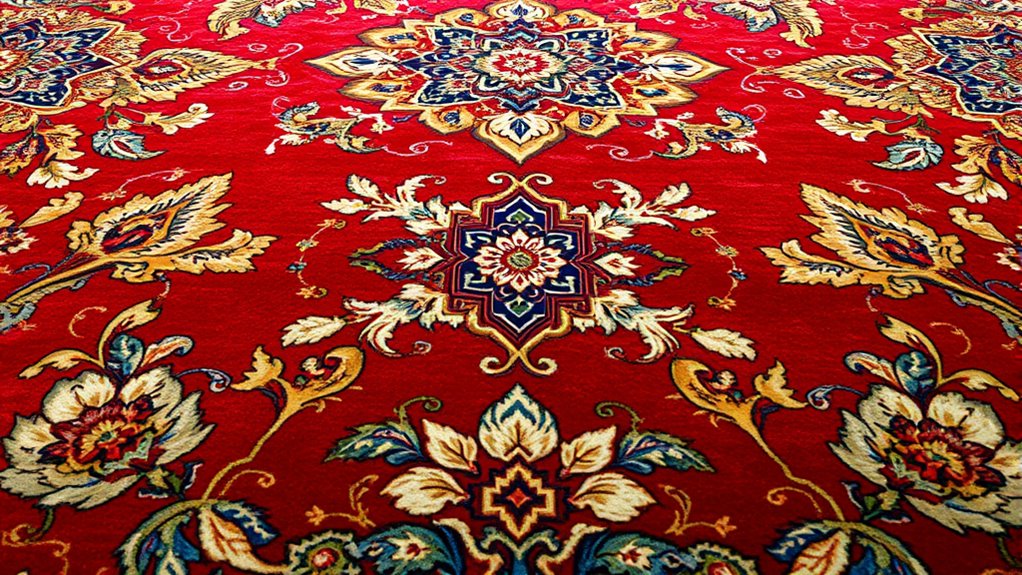
During the Safavid dynasty, Shah Abbas’s patronage transformed Persian carpet weaving into an art of imperial grandeur. His support led to the creation of the famous Shah Abbas Carpet, showcasing exceptional weaving techniques and intricate designs. You’ll notice the masterful use of knotting methods that produce dense, durable piles. The dyes used in these carpets relied on sophisticated dye formulas, resulting in vibrant, lasting colors. These rugs often feature geometric patterns and floral motifs symbolizing prosperity and divine authority. As a result, they became treasured royal possessions and trade masterpieces.
Shah Abbas’s patronage elevated Persian carpets to symbols of imperial power and artistic mastery.
- Expert weaving techniques create complex, detailed patterns
- Vibrant colors achieved through advanced dye formulas
- Royal workshops fostered innovation and craftsmanship
- These carpets reflected Persia’s cultural and political power
The Lost Royal Rugs of the Qing Dynasty: A Cultural Legacy
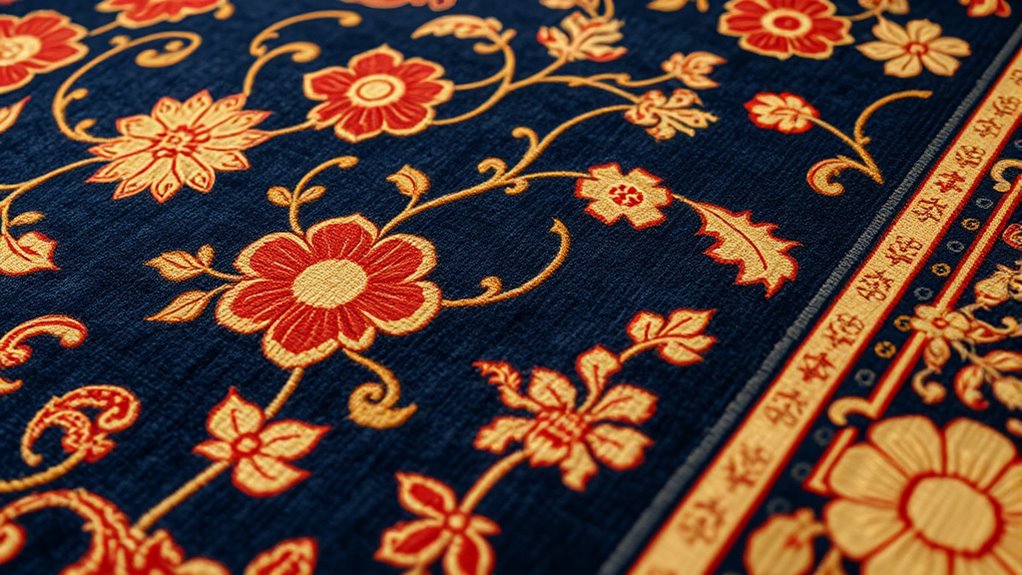
The Qing Dynasty’s rug heritage once showcased exquisite craftsmanship and imperial symbolism, but many of these iconic pieces have vanished. Their disappearance leaves a gap in understanding the empire’s cultural and artistic legacy. Without these rugs, we lose a essential connection to the dynasty’s rich history.
Qing Dynasty’s Rug Heritage
The Qing Dynasty’s royal rugs once adorned palace halls, showcasing the empire’s craftsmanship and aesthetic values. These textiles reflect a mastery of textile techniques and dynastic influences, blending traditional motifs with imperial symbolism. You’ll find intricate patterns inspired by earlier dynasties, yet uniquely Qing in style. The craftsmanship involved meticulous weaving and dyeing processes, creating vibrant, durable pieces. Key features include:
- Fine silk fibers with complex embroidery
- Use of auspicious symbols like dragons and phoenixes
- Layered color palettes with natural dyes
- Patterns reflecting Qing imperial authority and cultural ideals
These rugs served not only as decoration but also as cultural statements. Their design and craftsmanship reveal a sophisticated understanding of textile techniques and a deep connection to the dynastic influences shaping Qing artistry.
Disappearance of Iconic Pieces
Many of the Qing Dynasty’s most iconic royal rugs have vanished over time, leaving behind a tantalizing mystery for collectors and historians alike. Their disappearance often complicates efforts in provenance verification, making it difficult to confirm authenticity or origin. When these pieces surface, restoration techniques become vital to preserve their integrity and historical value. Without detailed records, it’s challenging to determine whether a rug is genuinely from the era or a modern reproduction. The loss of these iconic pieces highlights the importance of meticulous documentation and careful conservation. As you investigate these rugs, understanding how provenance verification and advanced restoration methods can authenticate and protect surviving treasures becomes essential to preserving this cultural legacy.
Cultural Significance Lost
As these iconic Qing Dynasty royal rugs disappear, the cultural stories and national pride they embody fade with them. This loss accelerates cultural erosion and deepens the loss of tradition, leaving a void in history. Without these rugs, future generations miss out on crucial links to their heritage. You might not realize how much history is woven into each pattern, symbolizing values and power. Their absence diminishes the richness of cultural identity.
- Traditional craftsmanship skills risk fading into obscurity
- Important stories behind motifs are forgotten
- The connection between history and art weakens
- The sense of national pride diminishes with each missing piece
The British Royal Collection: Notable Rugs in the Crown’s Holdings
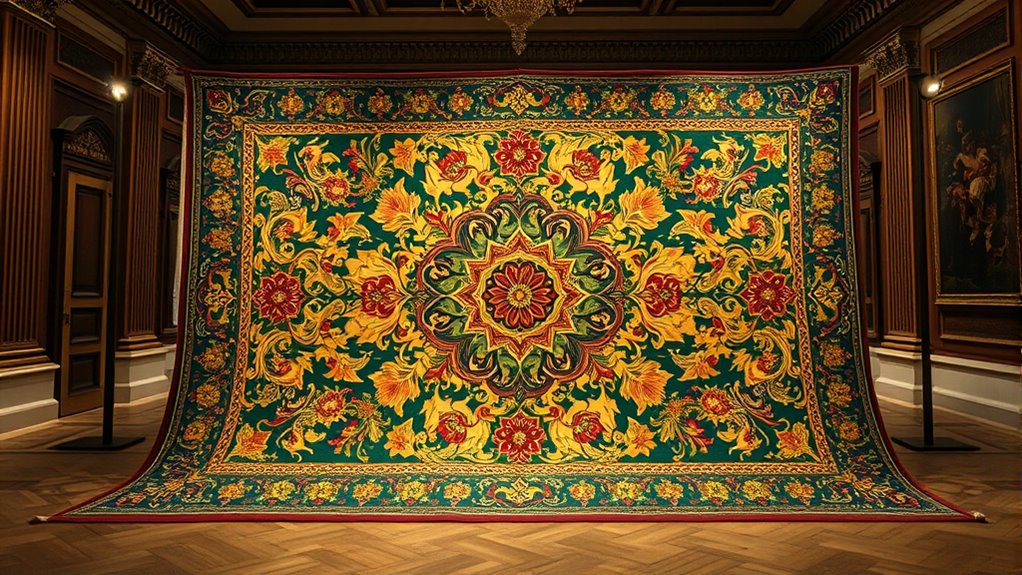
Within the British Royal Collection, several remarkable rugs stand out for their historical significance and exquisite craftsmanship. These pieces exemplify masterful rug weaving, showcasing intricate patterns and fine materials that reflect royal taste and tradition. Many of these rugs incorporate royal symbolism, with motifs representing authority, faith, and heritage. For example, some feature heraldic emblems or floral designs tied to specific royal events or families. Their provenance ties them directly to significant moments in British history, making them more than decorative items—they’re symbols of power and continuity. As you explore these notable rugs, you’ll see how craftsmanship and symbolism intertwine, offering insight into the monarchy’s cultural legacy. These treasures remain key pieces in the Crown’s holdings, embodying centuries of regal tradition.
The Sultan’s Gift: The Historic Ottoman Rugs Presented to European Monarchs

The Ottoman sultans regularly gifted intricately woven rugs to European monarchs as symbols of diplomatic goodwill and cultural prestige. These gifts showcased the artistry of rug weaving and conveyed royal symbolism, emphasizing power and respect. When you see these historic pieces, you can appreciate:
- The detailed craftsmanship that highlights Ottoman rug weaving techniques
- How the designs reflect royal symbolism, signifying status and authority
- Their role as diplomatic gestures strengthening alliances
- The cultural exchange represented by these luxurious gifts
These rugs weren’t just decorative; they embodied the Ottoman Empire’s mastery of textile art and served as tangible symbols of royal diplomacy. As you explore these historic pieces, you gain insight into the subtle language of royal gifting and the importance of craftsmanship in fostering international relationships.
Lessons From Royal Provenance Rugs: Artistry, History, and Preservation
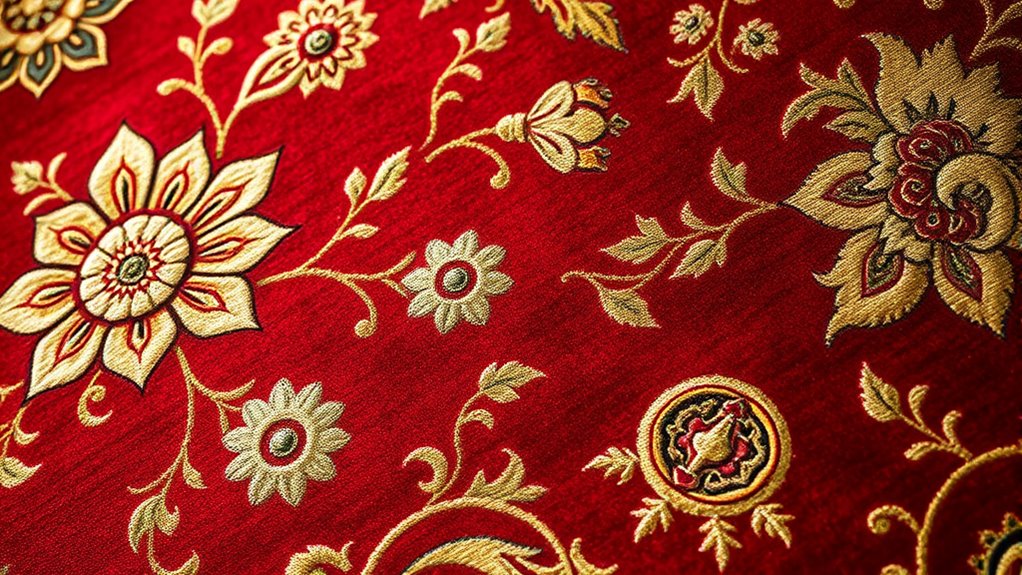
Royal provenance rugs teach us valuable lessons about artistry, history, and preservation that remain relevant today. Their fiber quality reveals the importance of selecting durable, high-quality materials to guarantee longevity. Paying attention to weaving techniques allows you to appreciate the craftsmanship and skill passed down through generations. These rugs demonstrate that intricate patterns and vibrant colors are not just decorative but also proof of advanced techniques and cultural significance. Preserving these masterpieces requires understanding their construction and caring for their fibers properly. By studying royal provenance rugs, you learn that maintaining their integrity involves both respecting traditional methods and adapting modern conservation practices. Ultimately, these rugs remind you that artistry and craftsmanship are timeless, and preserving them honors history for future generations.
Frequently Asked Questions
How Do Provenance and History Influence a Rug’S Value?
Provenance and history considerably influence a rug’s value because they affect market valuation and collector interest. When a rug has a well-documented background or notable origins, it becomes more desirable and commands higher prices. You can see increased collector interest for pieces with storied histories, making provenance a key factor in determining a rug’s worth. By understanding a rug’s history, you better appreciate its rarity and significance in the market.
What Techniques Differentiate Royal Provenance Rugs From Others?
You might think all rugs are created equal, but royal provenance rugs blow others out of the water with their weaving intricacies and dye techniques. These masterpieces feature incredibly detailed craftsmanship and vibrant, long-lasting colors achieved through centuries-old dyeing methods. Their unique weaving patterns often tell stories of royal history and prestige, making them unmistakably distinguished. You can see how these extraordinary techniques elevate their beauty, rarity, and value above ordinary rugs.
How Are Authentic Royal Rugs Preserved Over Centuries?
You can preserve authentic royal rugs over centuries by employing expert restoration techniques that stabilize fibers and repair damage. Using high-quality preservation materials helps prevent further deterioration and maintains the rug’s integrity. Properly controlling environmental factors like humidity and light exposure is essential. Regular inspections and careful cleaning also extend the rug’s lifespan, ensuring its historical and cultural significance remains intact for future generations.
What Are Common Signs of Authenticity in Royal Provenance Rugs?
Imagine holding a piece of history; authenticity markers reveal its true value. You’ll notice craftsmanship details like intricate knotting, vivid dyes, and precise symmetry that stand out. These signs of authenticity in royal provenance rugs distinguish genuine treasures from imitations. Pay attention to unique patterns, handwoven texture, and natural color variations—each tells a story of skilled artisanship. Recognizing these features guarantees you appreciate the rich legacy woven into every authentic royal rug.
How Do Royal Influences Reflect Cultural Exchanges in Rug Designs?
You can see how royal influences reflect cultural exchanges in rug designs through royal symbolism and cultural motifs. These elements often incorporate symbols of power, spirituality, or tradition, blending styles from different regions. When you observe intricate patterns or specific motifs, it shows how different cultures shared ideas and aesthetics, enriching the design. This exchange highlights the historical connections and mutual influences that shaped the unique beauty of royal provenance rugs.
Conclusion
You now know that over 50 royal rugs, including the iconic Ardabil and Mughal pieces, reveal centuries of cultural heritage and exquisite craftsmanship. These masterpieces aren’t just beautiful—they hold stories worth centuries of preservation. By understanding their rich history, you can appreciate the artistry behind each knot and pattern. Remember, safeguarding such treasures ensures that future generations can continue to marvel at these priceless symbols of royal legacy.
